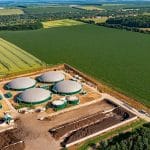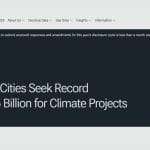Cities Face $105 Billion Funding for Climate Resilience: CDP Finds

• Global cities’ climate investment needs have surged 22% year-on-year to US$105 billion in 2025.
• Green infrastructure and nature-based projects are expanding fastest, more than quadrupling since 2020.
• Despite rising ambition, 87% of projects still seek financing, with half yet to secure any funds.
Urban Climate Demand Surges Past US$100 Billion
For the first time, the world’s cities are seeking over US$100 billion to finance climate infrastructure and resilience projects, according to CDP’s 2025 Global Snapshot. The analysis—produced with the Global Covenant of Mayors for Climate & Energy (GCoM)—shows urban climate investment demand has jumped from US$86 billion in 2024 to US$105 billion in 2025, reflecting a steep 22% increase.
The report draws on disclosures from 507 cities across 62 countries through CDP-ICLEI Track, encompassing 2,164 projects. Released during the COP30 Local Leaders Forum in Rio de Janeiro, the findings capture the accelerating pace of local climate planning amid constrained access to capital.
Buildings and energy efficiency dominate 2025 project portfolios (420 projects), followed by green infrastructure (338) and transport (336). Examples include Porto’s effort to electrify 43% of its bus fleet by 2027, Freetown’s “Treetown” initiative tracking 1.2 million trees, and Buenos Aires’ community solar program expected to cut 217,000 tonnes of CO₂ annually.
Financing Gaps Undermine Urban Progress
While ambition grows, financing remains the missing link. CDP data show 87% of projects disclosed this year require funding, with nearly half still unfunded. Emerging markets face greater challenges: 40% of their projects seek full financing compared to 22% in developed economies. Only 7% of projects that identified a financing model rely exclusively on private capital, and almost half are still in early scoping stages.
Investment concentration is also skewed. Developed economies represent 83% of reported financial needs, led by the United States (44%) and the United Kingdom (23%), even though emerging-market cities account for 40% of projects.
CDP’s companion report, Protected Places, highlights how these funding disparities translate into uneven progress. In India, just 5% of climate actions are fully implemented, compared to 75% in Japan and 86% in China. Implementation rates in Latin America and Africa are 23% and 31%, respectively—illustrating the persistent imbalance between ambition and execution.
RELATED ARTICLE: CDP and EFRAG Strengthen ESRS Alignment to Ease Corporate Reporting
Nature-Based Solutions Gain Momentum
Among the strongest growth areas are nature-based projects targeting biodiversity, water resilience, and green urban spaces. Between 2020 and 2024, such initiatives rose from 7% to 15% of total disclosed projects—equivalent to a fourfold increase in both number and scale. Cities are increasingly turning to tree restoration, wetland recovery, and green corridors to counter heat stress, enhance livability, and protect biodiversity within dense urban areas.
This shift marks a growing recognition of nature as both a mitigation and adaptation asset. Yet, without sustained finance pipelines, the potential remains largely untapped.
Bridging the Trillion-Dollar Gap
The US$105 billion disclosed in 2025 is only a fraction of what cities need to deliver climate resilience at scale. Global estimates suggest that urban areas require about US$4.5 trillion annually for mitigation and adaptation. Less than 10% of total climate finance currently reaches cities, leaving most local governments reliant on national or multilateral intermediaries.
To address this, CDP and GCoM are urging policymakers and investors to strengthen city-level access to finance ahead of COP30. Proposed actions include embedding local climate priorities into Nationally Determined Contributions (NDCs), developing risk-sharing mechanisms to attract private capital, expanding initiatives such as the Coalition for High Ambition Multilevel Partnerships (CHAMP), and improving disclosure to build investor confidence.
Policy and Investment Imperatives
Katie Walsh, CDP’s Head of City Climate Finance, said the findings show both the growing determination of cities and the urgent need to unlock finance. “Our latest Snapshot reveals both the size of their response and the glaring scale of the investment needed—now topping US$100 billion for the first time. The financing tap for cities, especially in developing economies, must be fully opened to turn plans on paper into projects on the ground.”
Asma Jhina, Senior Advisor at GCoM, echoed this call, warning that “the gulf between city climate ambition and critical finance remains stark.” Nearly half of all disclosed projects remain unfunded, with emerging markets facing the steepest barriers to capital.
Global Relevance
For investors, the data reinforce the growing role of cities as frontline actors in climate action—and as a potential engine of sustainable finance flows. For policymakers, they underline the need for governance reform that enables cities to access global finance mechanisms directly.
With climate impacts intensifying and urban populations swelling, the ability of cities to mobilize funding at scale will shape not only national emissions pathways but the planet’s broader resilience trajectory. As COP30 approaches, CDP’s findings leave little doubt: global climate goals depend increasingly on empowering the world’s cities to act.
Follow ESG News on LinkedIn








